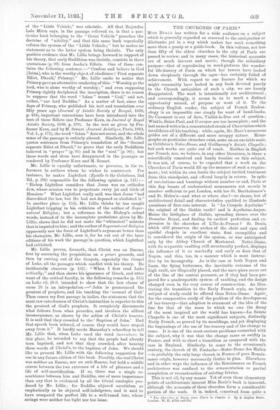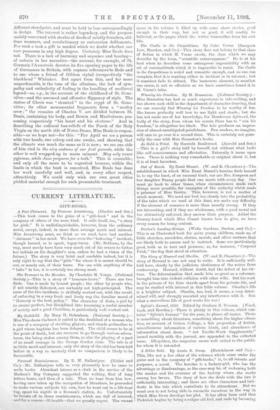THE CHURCHES OE' PARIS.* Miss BEALE has written for a
wide audience on a subject which is generally regarded as reserved to the antiquarian or dilettante, yet in a way which makes her work something more than a gossip or a guide-book. In this volume, not less- than fifty of the oldest churches in the city of Paris are passed in review, and in many oases, the historical accounts are of much interest and merit; though the subsidiary purpose—that of reproducing in word-pictures the wonder- ful life-history of Paris on which her towers have looked down sleeplessly through the ages—has certainly failed of achievement. With regard to one feature for which we might reasonably have looked in any book devoted purely to the Church antiquities of such a city, we are keenly disappointed. The work is intentionally not architectural ; and correspondingly, it seems to us to mark a distinct opportunity missed, of purpose or want of it. To the ordinary English reader, the subject of French Ecclesi- ology is an impossible one simply for want of hand-books. Be Caumont is out of date, Viollet-le-Duc out of question ; Winkle, Saint-Paul, and Corroyer are too incomplete ; and the last named writes in a concentrated strain of Chauvinism which invalidates all his teaching : while, again, Mr. Hare's numerous guides are of a different and more scrappy nature. Mono- graphs on particular churches exist, some on an enviable scale, as Celtilahre's Notre-Dame, and Guilhernay's Sainte Chapelle; but such works are quite out of reach. Neither in English nor French, nor, we believe, in any other literature, is there a scientifically conceived and handy treatise on this subject_ It was not, of course, to be expected that a work on. the Churches of Paris would fill up the measure of such a require- ment; but within its own limits the subject invited treatment from this standpoint, and offered largely in return. In spite of revolutions and burnings without number or end, Paris at this day boasts of ecclesiastical monuments not merely in number sufficient to put London, with her St. Bartholomew's and St. Helen's—and what or where else P—to shame, but of architectural detail and characteristics qualified to illustrate questions of first-rate interest. Is "La Coupole Aquitaine " the original of the Gothic vault ? and is Aquitaine-Anjou- Maine the birthplace of Gothic, spreading thence over the Domaine Royal, and finding its earliest perfection and ex- pression in the churches of L'Ile.de-France P St. Denis, which still preserves the arches of the choir and apse and apsidal chapels in excellent state, first exemplifies an& is considered the origin of the system, or was anticipated only by the Abbey Church of Morienval. Notre-Dame, with its sexpartite vaulting still structurally perfect, displays the influence of it as markedly and early as does that of Noyon, and this, too, in a manner which is most instruc. tive by its incongruity. As is the case at both Noyon and Leon, the flying buttresses, the inevitable outcome of the high vault, are illogically placed, and the nave-piers occur out of the line of the central pressure, as if they had been pre- pared for a quadrupartite system of vaulting, and the design changed even in the very corn-se of construction. As illus- trating the transition to the Early French style, no better subject of study could be offered than Notre-Dame. Again,. for the comparative study of the problem of the development of bar-tracery—that adoption in ornament of the idea of the line for that of the mass to which we owe the decay of the most inspired art the world has known—La Sainte Chapelle is one of the most significant subjects, distinctly Early French, as proved by its mouldings, and yet displaying the beginnings of the use of bar-tracery and of the change to come. It is one of the most curious problems connected with the subject, why it was that the change came so swiftly in France, and with so short a transition as compared with the case in England. Similarly, to come to the seventeenth century, the church of St. Eustache—Notre-Dame des Halles —is probably the only large church in France of pure Renais- sance origin, however necessarily Gothic in plan. Elsewhere and in other ways the influence of the Renaissance on French architecture was confined to the ornamentation or partial completion or reconstruction of existing fabrics.
This is not all, by any means. Yet of even these elementary points of architectonic interest Miss Scale's book is innocent, although the accounts of these churches form a considerable portion of the work. It is, indeed, conceived from qpite a.
* The Churchox of Paris, from Clods to Choriee X. By B. Sophia Beale. London : W. Allen and Co. different standpoint, and must be held to lose correspondingly in design. The interest is rather legendary, and the purpose mainly concerned with stories of deeds of saintly founders, old- time manners, and revolutionary or restoration defilements. For such a task a gift is needed which we doubt whether our race possesses in any high degree. Certainly Miss Beale does not. There is a lack of harmony and sequence and bearing— of entrain in her narrative—the account, for example, of St. Germain l'Auxerrois devotes its five opening pages to the life of Germanus in Britain, with copious references to Bede and to one whom a friend of Gibbon styled irrespectively "the blockhead" Whitaker. But apart from this, and far more unpardonable, is the tone of the allusions, the lack of sym- pathy and catholicity of feeling in the handling of mediteval legend—as, e.g., in the account of the childhood of St. Gene. vi6ve—and the assumed and offensive flippancy of style. The statue of Clovis was " shunted " to the crypt of St. Gene- vieve; its other monumental fragments form a "motley crew ; " the remains of Charles V. are divided between St. Denis, containing his body, and Rouen and Maubuisson, pos. sessing respectively "his heart and his etceteras." And in describing the zodiacal bas-reliefs of the Porch of the Holy Virgin on the north side of Notre-Dame, Miss Beale is respon- sible—or we hope not—for this : "For April we see a person with two heads, one asleep and one awake, and showing that the climate was much the same as it is now; we see one side of him clad in the airy costume of our first parents, while the other is well wrapped-up in warm raiment. May only wears pyjamas, while .Tune prepares for a bath." This is execrable; and only all the more to be regretted because, within the limits in which the book is conceived, Miss Beale has done her work carefully and well, and, in every other respect, attractively. We could only wish our own great cities yielded material enough for such presentable treatment.







































 Previous page
Previous page